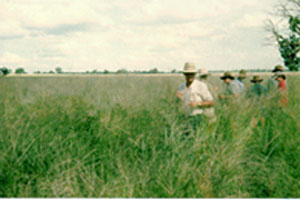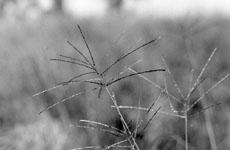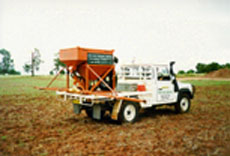
Digit grass - a versatile warm-season grass
Introduction

Digit grass Digitaria eriantha subsp. eriantha (formerly Digitaria smutsii) or Smuts finger grass is a palatable good quality summer-growing perennial grass suited to a range of soils on the north-west slopes, north-west plains, sections of the northern tablelands and sections of the central west slopes and plains of New South Wales. This photo shows a 3-year-old Premier digit grass pasture sown on a sandy loam soil paddock in the Gilgandra district.
Origin
Digit grass is native to South Africa. It grows on the more fertile soils in summer-rainfall areas which have 400–1000 mm average annual rainfall. It is an important sown pasture species in South Africa.
History of digit grass in NSW
Early experiments conducted by the NSW Soil Conservation Service and the NSW Department of Agriculture from 1956 demonstrated the adaptation and persistence of digit grass at a number of sites in northern NSW.
- On a solodised red-brown earth at Bundarra (elevation 654 m) on the New England Tablelands, digit grass developed a cover and competed strongly with weeds (Buckley, 1959). This sowing was into a once-cultivated native pasture of pitted blue grass Bothriochloa decipiens in August 1956. That spring was notable for its late frosts, and the summer and following year were droughty. However, by the end of the 1958–59 summer, pitted blue grass had been completely displaced by the digit grass swards.
- Trials and commercial sowings of digit grass in the Dubbo, Gilgandra, Trangie, Warren and Nyngan districts survived the severe drought of 1994 impressively. Digit grass has continued to persist and perform with distinction in these districts.
- In tropical grass species evaluation trials conducted by Eric Darley (former District Agronomist, Moree), digit grass survived the major drought of 1965 and was highlighted as a promising grass for light-textured soils of the north-west slopes.
- At Inverell, digit grass has persisted under grazing, without spreading, on a brown, heavy-clay, basaltic soil for over 35 years. This trial was established by Dr Vic Gidley (former District Agronomist, Inverell).
- On a red earth at ‘Turinga Downs’, North Star, digit grass persisted for over 15 years. This demonstration was established by John Fahey, a former Research Agronomist with NSW Agriculture.
- In a number of trials established in the Baradine, Coonabarabran, Binnaway, Gilgandra, Elong and Coolah districts since 1990, digit grass has persisted and performed extremely well under commercial grazing conditions. It has persisted well for over a decade in the Coonamble district, and performed well in the Tenterfield district.
Main agronomic attributes
Digit grass:
- is a very persistent, productive and drought-tolerant species;
- is very well adapted to light-textured soils and red loam soils;
- tolerates acid soils and moderate to high levels of exchangeable aluminium;
- does not appear to respond to lime; however, the companion legume may respond resulting in nitrogen benefits to the pasture;
- although frost-susceptible, has better cool-season activity than most tropical grasses and is up to 3 weeks ahead of Rhodes grass and native Bothriochloa species in spring growth;
- grows longer into autumn and earlier in spring than most summer grasses;
- is particularly suited to the transitional zone of adaptation between temperate and tropical species;
- should not be sown into country that currently supports valuable native species - its main role is for sowing in previously cultivated country where it takes too long for natives to return (often 10 years or more) or where valuable natives have disappeared as a result of overgrazing;
- has good drought and fire tolerance;
- is suitable for short-duration hard grazing by beef cattle and sheep - it tolerates close grazing by sheep;
- has low levels of soluble oxalate and therefore has low risk of causing oxalate-related animal health problems.
See also Agnote DPI-301 Digit grass (part of the Pasture Planner series).
Suitable soil types
As a general rule, digit grass is best suited to the reasonably fertile, medium and light textured soils. It is not as suited to the heavy, cracking clay soils of the north-west plains as is Bambatsi panic and purple pigeon grass. It is unsuited to the deep-cracking black soils (Vertosols) of the Darling Downs in Queensland.
Digit grass has performed well on:
- sandy textured solodic soils
- podzolics
- trap rock country (solodised soils derived from metasediments)
- granitic soils
- red-brown earths
- well structured soft brigalow–belah clay loams.
It has performed well on a medium clay soil at Baradine for 7 years and it persists and grows well on the hard-setting red-brown clays around Trangie, Warren and Nyngan. Digit grass has also performed well on acid sandy loam soils; with medium to high exchangeable aluminium levels. It was the best performing grass on a sandy loam soil at Elong where the exchangeable aluminium was 34% of the total cation exchange capacity.
Generally, digit grass does well on soils that grow the native Bothriochloa species (pitted blue grass and the red-leg grasses).
General description

- Digit grass is a tufted perennial with a short rhizome.Culms are erect to 150 cm or more tall.
- The flowerhead consists of raceme-like panicles arranged in three whorls on a central axis.
- When grazed close by sheep, the tussocks develop a more prostrate growth habit to form a cover.
Cultivars
Premier and Apollo are the two cultivars. In spring, Apollo can come away slightly earlier than Premier. The differences, although experimentally significant, have not been regarded as economically significant.
- Apollo produces lower seed yields, and interest in it has languished.
- Premier is the only cultivar commercially available. It is a public-owned variety, which means that Premier seed can be harvested and freely traded by any person.
Seasonal growth pattern
Depending on the environment (temperature and moisture), digit grass grows mainly from early September to the end of March:
- Peak growth, given available water, is from around early November to the middle of March. At its most rapid growth rate, up to 75 kg/ha/day of dry matter can be produced.
- It will grow at a lower rate from early September to early November, and from mid-March to the end of May.
- It is dormant through the coldest part of winter.
Sowing and establishment
Refer to Agnote DPI-156 Successful establishment of tropical perennial grasses in North West NSW.
Seed is sown from early spring through to January–February. Sowing; time can be dictated by likely weed competition. Spring sowings, although; preferred in some areas, may not be advisable because of weed competition.
- In much of the central west, the best time to sow is November–December. The highest probability of rain is mid-December to mid-February and this is when the highest probability of establishment occurs. In the Coonamble–Walgett district, the best sowing time is January–February.
- On the north-west slopes and plains north of a line of latitude through Bingara, mid-January to mid-February sowings are favoured, especially where summer weeds are troublesome. In the Inverell district, spring sowings are also recommended. On the northern slopes south of this arbitrary line, a spring sowing is preferred, unless weed competition is expected to be significant.
- On the eastern fall of the Tenterfield district, a February sowing is favoured to take advantage of reliable late summer rains.
Surface sowing onto a cultivated seedbed with light-covering harrows is suitable:
- A firm, shallow, moist seedbed, less than 5 cm deep, with good stored moisture reserves below, is ideal.
- Rolling with a rubber-tyred roller is often advantageous.
- Do not sow deeper than 10 mm.
- Very shallow direct drilling with narrow points and press wheels is suitable.
- Do not roll country which is prone to crusting

Sow at the rate of 1–2 kg seed/ha. Mix seed with a suitable carrier to facilitate flow through the fertiliser box of a conventional combine. Grass air-seeders (as seen at right) and roller drum seeders, followed by light-covering harrows, are suitable.
Companion legumes
Productive high quality digit grass pastures will have a legume component. This is essential if the quality of the pasture is to be maintained. Winter annuals are favoured, especially serradella, sub clover and medics. The choice depends on location, soil type and pH.
- On better soils, lucerne can be grown; however, strict rotational grazing management practices must be used to maintain lucerne.
- Where digit grass is sown in spring/summer, annual legumes can be introduced in the following autumn. Annual legumes can also be undersown with a winter cereal grain crop, and digit grass established the following spring/summer.
Companion perennial grasses
Sowing two or more perennial species in a pasture has the advantages of greater pasture diversity and a greater spread of risk. Sometimes one species germinates well and the other doesn’t. Reasons for this are sometimes obscure but include different germination requirements and variable levels of dormant seed. Certain circumstances (for example droughts or grazing management) can favour one species over another. While one species may be more palatable at a given grazing time than the other species, generally few grazing management problems have occurred with companion perennial grass sowings.
In the central slopes and central west where acid sand/sandy loam textured soils are moderate to high in exchangeable aluminium, an option is to sow digit grass with other perennial grasses such as consol lovegrass and Rhodes grass. Digit grass and companion species like consol are generally relatively hardy and coexist well together.
Fertiliser
The majority of soils in the north-west and central west are deficient in sulfur and/or phosphorus. Digit grass will grow in low-fertility situations, but results will be poor without the use of fertilisers and a suitable legume. Fertiliser programs are generally essential to ensure companion legumes (e.g. sub clover) grow well and indirectly supply nitrogen to the perennial grass.
Weed control
Very good weed control is essential for good pasture establishment. Good control is generally achieved through summer fallowing prior to a winter crop,with digit grass sown during the following spring/summer.
Where no previous summer weed control has been undertaken, it is often best to wait for the germination of warm-season weeds so that they can be killed with an appropriate herbicide before sowing.
ALWAYS READ THE LABEL
Users of agricultural (or veterinary) chemical products must always read the label and any Permit before using the product, and strictly comply with the directions on the label and the conditions of any Permit. Users are not absolved from compliance with the directions on the label or the conditions of the Permit by reason of any statement made or not made in this publication.
Grazing management
As a general rule, digit grass is a robust plant that can tolerate a range of grazing systems.
- Ideally, follow a period of grazing (e.g. 7–40 days) with rest periods to allow replenishment of root reserves and a periodic chance to re-seed.
- The best quality feed is the young regrowth prior to re-heading.
- Aim for at least one seeding per year.
Livestock growth will be optimised when grass growth is kept relatively short and legumes are maintained in the sward. Paddock subdivision will provide better flexibility in management.
Animal performance
There are no comparative animal performance data for digit grass pastures in NSW.
Seed production
Refer to Agnote DPI-403 Digit grass seed production.
Pests and diseases
Digit grass does not have specific insect pests.
Diseases of digit grass are as follows:
- In humid moist environments seed heads can be infected by false smut (Elphelis sp.).
- In coastal areas the foliage can be infected by the same rust (Puccinia oahuensis) that infects pangola grass.
Pasture improvement - be cautious
Pasture improvement may be associated with an increase in the incidence of certain livestock health disorders. Livestock and production losses are possible from some disorders. Management may need to be modified to minimise risk. Consult your veterinarian or adviser when planning pasture improvement.
The Native Vegetation Conservation Act 1997 (www.legislation.nsw.gov.au) restricts some pasture improvement practices where existing pasture contains native species. Inquire through your office of the Department of Land and Water Conservation for further details.
Reference
Buckley KS 1959, ‘Plant testing for soil conservation at Inverell’, Soil Conservation Journal of NSW, 15, 308–313.
Acknowledgments
Sincere thanks to the following people who provided technical and practical information:
Robin Horn, digit grass seed producer, Millmerran, Qld
Brian Johnston, Senior Experimentalist, QDPI, Toowoomba, Qld
David Lloyd, Senior Pasture Agronomist, QDPI, Toowoomba, Qld
Ian Hewetson, digit grass seed producer, Mallanganee, NSW
Gordon Lummis, digit grass seed producer, ‘Wilga View’, Curban, NSW
Jeff Lowien, District Agronomist, Glen Innes, NSW
Bob McGufficke, District Agronomist, Inverell, NSW
Thanks also to Warren McDonald, Technical Specialist, Pastures (NSW Agriculture, Tamworth) and John Read, Program Leader, Pastures North (NSW Agriculture, Orange) for reviewing the draft documents.

